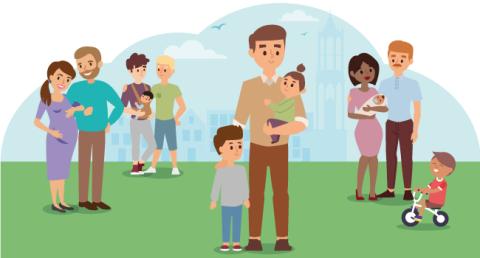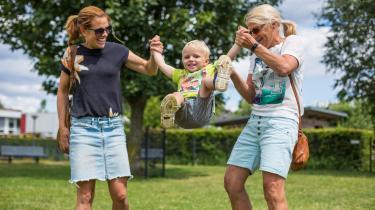The first 1000 days of children in Utrecht
- Extended Summary
-
Image

The first 1,000 days of a child's life (from conception to age 2) are critical to a child’s health and well-being, both during that initial period and throughout the rest of their life. During this period, the foundations are laid for physical, psychological and social development (Roseboom, 2018). With the information from this special issue, professionals, policymakers and administrators can engage in discussion about how to ensure a promising start for even more children.
Most young children in Utrecht are doing well
The Youth Healthcare Service (JGZ) has no concerns about the development of the majority of children aged 0–2. Compared to the other three major cities and nationally, children in Utrecht are doing better, both before and immediately after birth. We are also seeing several positive developments in recent years: the rate of preterm births and/or low birth weight has decreased, the percentage of vaccinated 2-year-olds appears to be increasing slightly, smoking is less common at home, and the percentage of women who smoke during pregnancy is decreasing.
Approximately 2,500 young children in Utrecht face increased risk in their development
JGZ is monitoring approximately 2500 children in Utrecht from the age of 0 to 2 extra closely. This is 18% of that age group. They are more likely to have an accumulation of risk factors. Risk factors may be present in the social domain (e.g., single-parent family or unemployment), in the developmental domain (e.g., developmental problems or language/speech impairment), and may include health problems in family members or risk factors relating to pregnancy and childbirth (e.g., preterm birth or unwanted pregnancy).
One key risk factor for child development is parental stress (Pharos, 2019). 22% of parents report experiencing stress, mainly due to work, parenting and health. The ongoing coronavirus pandemic is causing additional stress, anxiety and depression, especially for families who were already in a vulnerable situation. Most parents are healthy, although over one in ten report limitations in their daily lives due to their own health.
There are major differences between children according to their parents' educational level, migration background, and the neighbourhood they grow up in
There are major differences according to the parents' educational attainment and, to a lesser extent, migration background of the children. This may exhibit in differences in the risk of accumulation of problems, delayed speech and language development, childhood overweight, parents smoking in the home, and social support network of parents. These differences are generally to the detriment of children of parents with low educational attainment or children from a migration background (especially a non-Western migration background).
Children in the districts Overvecht and Zuidwest have a lower chance of a good start. Children in these neighbourhoods are more likely to grow up in poverty, more likely to be overweight at an early age, and more likely to have parents who smoke. The use of the community team in these neighbourhoods is, in turn, higher than the average in Utrecht.
An important point to note is that health disparities increase as children grow older. [KNAW2018] We already see differences in overweight by educational level and migration background at ages 2 and 3, and these differences widen at primary school age. This highlights the importance of investing in the first 1000 days of children's lives.
Childhood overweight by parents’ educational level Children living in poverty, who have experienced a severe stressor in the family or who have parents in a vulnerable situation are at greater risk in their development
The following risk factors are important reasons for the Youth Healthcare Services (JGZ) to pay extra attention to children: poverty, having experienced a serious stressor in the family, parents who fled to the Netherlands and parents with a mental illness, addiction or intellectual disability. Attention to children in these families is especially urgent during the coronavirus pandemic, because children and families in vulnerable situations are generally more severely affected by it.
Half of children at risk in their development have parents with high educational attainment
Despite the reduced likelihood, children of parents with high educational attainment can also face an increased risk in their development. 78% of parents in Utrecht are highly educated; therefore half of the group of children in a vulnerable situation in Utrecht have parents with high educational attainment. The accumulation of risk factors tends to be less complex in children of these parents than in those of parents with low or medium educational attainment, as the risk factors are often limited to a single domain.
The parents’ social and professional network is extremely important
76% of parents of young children ask for parenting help and advice. In addition to family and friends, youth health care, daycare and the GP are important sources of support.
Accounts from mothers in vulnerable situations show that they do not receive sufficient social support from their partners, family and friends. They also need better alignment with existing care.
Maternity care and youth health care are offered to all parents. Most of them make use of the services. Care by the community team, youth care and other specialized care is available as needed. Preschool education is available for children with delayed language development. Participation in preschool education decreased from 89% in 2017 to 67% in 2020. Approximately 850 children aged 0–2 were in contact with a Youth and Family community team in 2020; the Overvecht, Kanaleneiland and Lunetten districts more often had contact with the community team than on average in Utrecht. Additional youth assistance is still rare among 0–2 year olds. 26 children aged 0–2 were removed from their homes in 2020.
- Methods
-
Sources
The results in this special issue are primarily based on registration data from JGZ's digital record, supplemented with care data and data from PerinedNational perinatal registration data, the Health Survey, the Residents Survey and the Utrecht resident panel. The text and figures on the data use rounded percentages. As such, the percentages of all categories combined may not always add up to 100%. The interviews with care professionals and mothers in vulnerable situations also served as an important source of information. Most of the data is from before the coronavirus pandemic. We have indicated the potential impact of the coronavirus pandemic based on national and international research conducted during the pandemic.
Differences by educational attainment, migration background and neighbourhood
In the text, we mention differences by parents’ educational attainment, migration background and neighbourhood. Education influences the type of work, financial opportunities, social environment and knowledge and health skills of people. Educational attainment is, therefore, an important summarising characteristic that provides insight into health opportunities and inequality.
In this issue, we distinguish between three categories of parental educational attainment, with intra-family educational attainment set at the level of the parent with the highest completed education. For the sake of readability, we use the shortened terms “low”, “medium” and “high” educational attainment. The categories are equivalent and alternative wording can be used if desired.
Education completed Category primary education, secondary school, secondary vocational education (level 1) Low Senior general secondary education, pre-university education, secondary vocational education (levels 2–4) Medium University of applied sciences, university High Because 78% of parents in Utrecht have completed academic education, the available data often only allowed a distinction between parents with high educational attainment and parents with low or medium educational attainment.
The classification of migration background is based on criteria provided by Statistics Netherlands (CBS). This only considers the parents’ country of birth. Children in Utrecht without a migration background have parents who were both born in the Netherlands. If at least one of the parents was not born in the Netherlands, the child is considered to have a migration background. This is further broken down into Moroccan, Turkish, other non-western, and western.
Public Health Monitor Utrecht
This special edition is part of the Public Health Monitor Utrecht and provides important input for the Utrecht Health Profile. For more information, figures and publications on the health of Utrecht's youth, visit www.volksgezondheidsmonitor.nl. The website also provides information about the health of adults and the elderly in Utrecht.
